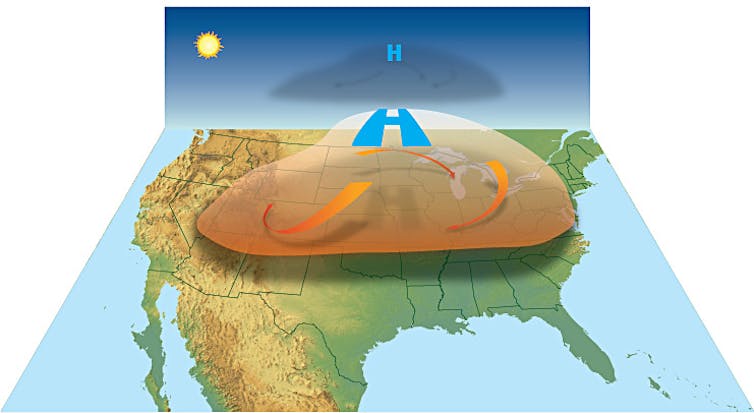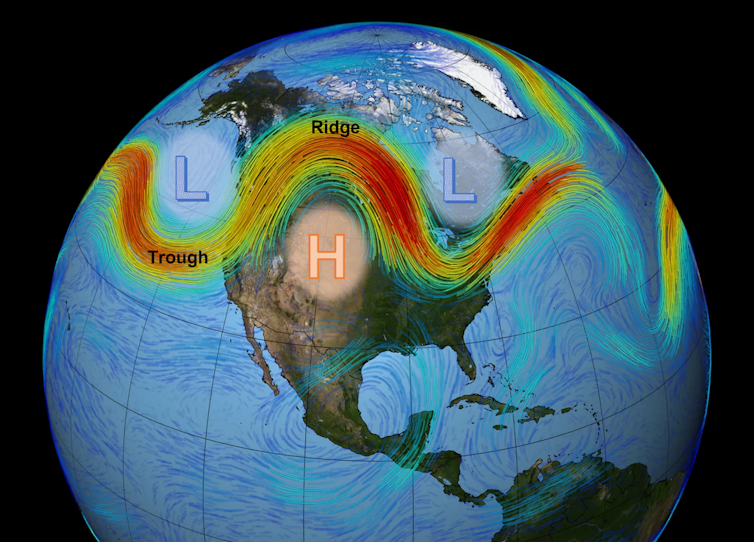
By Shuang-Ye Wu
Summer 2024 was officially the Northern Hemisphere’s hottest on record. In the United States, fierce heat waves seemed to hit somewhere almost every day.
Phoenix reached 100 degrees for more than 100 days straight. The 2024 Olympic Games started in the midst of a long-running heat wave in Europe that included the three hottest days on record globally, July 21-23. August was Earth’s hottest month in the National Oceanic and Atmospheric Administration’s 175-year record.
Overall, the global average temperature was 2.74 degrees Fahrenheit (1.52 degrees Celsius) above the 20th-century average.
That might seem small, but temperature increases associated with human-induced climate change do not manifest as small, even increases everywhere on the planet. Rather, they result in more frequent and severe episodes of heat waves, as the world saw in 2024.
The most severe and persistent heat waves are often associated with an atmospheric pattern called a heat dome. As an atmospheric scientist, I study weather patterns and the changing climate. Here’s how heat domes, the jet stream and climate change influence summer heat waves and the record-hot summer of 2024.
What the jet stream has to do with heat domes
If you listened to weather forecasts during the summer of 2024, you probably heard the term “heat dome” a lot.
A heat dome is a persistent high-pressure system over a large area. A high-pressure system is created by sinking air. As air sinks, it warms up, decreasing relative humidity and leaving sunny weather. The high pressure also serves as a lid that keeps hot air on the surface from rising and dissipating. The resulting heat dome can persist for days or even weeks.
The longer a heat dome lingers, the more heat will build up, creating sweltering conditions for the people on the ground.

NOAA
How long these heat domes stick around has a lot to do with the jet stream.
The jet stream is a narrow band of strong winds in the upper atmosphere, about 30,000 feet above sea level. It moves from west to east due to the Earth’s rotation. The strong winds are a result of the sharp temperature difference where the warm tropical air meets the cold polar air from the north in the mid-latitudes.
The jet stream does not flow along a straight path. Rather, it meanders to the north and south in a wavy pattern. These giant meanders are known as the Rossby waves, and they have a major influence on weather.

NASA/Goddard Space Flight Center Scientific Visualization Studio
Where the jet stream arcs northward, forming a ridge, it creates a high-pressure system south of the wave. Where the jet stream dips southward, forming a trough, it creates a low-pressure system north of the jet stream. A low-pressure system contains rising air in the center, which cools and tends to generate precipitation and storms.
Most of our weather is modulated by the position and characteristics of the jet stream.
How climate change affects the jet stream
The jet stream, or any wind, is the result of differences in surface temperature.
In simple terms, warm air rises, creating low pressure, and cold air sinks, creating high pressure. Wind is the movement of the air from high to low pressure. Greater differences in temperature produce stronger winds.
For the Earth as a whole, warm air rises near the equator, and cold air sinks near the poles. The temperature difference between the equator and the pole determines the strength of the jet stream in each hemisphere.
However, that temperature difference has been changing, particularly in the Northern Hemisphere. The Arctic region has been warming about three times faster than the global average. This phenomenon, known as Arctic amplification, is largely caused by the melting of Arctic sea ice, which allows the exposed dark water to absorb more of the Sun’s radiation and heat up faster.
Because the Arctic is warming faster than the tropics, the temperature difference between the two regions is lessened. And that slows the jet stream.
As the jet stream slows, it tends to meander more, causing bigger waves. The bigger waves create larger high-pressure systems. These can often be blocked by the deep low-pressure systems on both sides, causing the high-pressure system to sit over a large area for a long period of time.

Typically, waves in the jet stream pass through the continental United States in around three to five days. When blocking occurs, however, the high-pressure system could stagnate for days to weeks. This allows the heat to build up underneath, leading to blistering heat waves.
Since the jet stream circles around the globe, stagnating waves could occur in multiple places, leading to simultaneous heat waves at the mid-latitude around the world. That happened in 2024, with long-lasting heat waves in Europe, North America, Central Asia and China.
Jet stream behavior affects winter, too
The same meandering behavior of the jet stream also plays a role in extreme winter weather. That includes the southward intrusion of frigid polar air from the polar vortex and conditions for severe winter storms.
Many of these atmospheric changes, driven by human-caused global warming, have significant impacts on people’s health, property and ecosystems around the world.
![]()
Shuang-Ye Wu is Professor of Geology and Environmental Geosciences at the University of Dayton.




























DaleL says
Anyone who has studied Earth’s distant past knows about “snowball Earth” which occurred 620 to 700 million years ago. The entire planet was frozen to the equator. In comparison the Quaternary glaciation period of the last 2.6 million years has been relatively mild. Except for brief interglacial periods, most of North America, Asia, and Europe were covered by glacial ice until about 12,000 years ago. However, the equator remained warm and tropical.
During the age of dinosaurs and into the early Cenozoic, Earth was warm. 55 million years ago, there were alligators living in what is now Alaska. So what happened? Why did Earth get so cold? Grass happened (bamboo, maize, wheat, prairie grasses, etc.). Grasslands now constitute 40% of the land area of Earth, excluding Antarctica and Greenland. Prairie soil is rich, black, and full of sequestered carbon.
Then we came along. Thanks to us, Earth is not heading into another glaciation. The newspaper headlines are not reporting on the North American glacial expansion threatening Detroit or Toronto. Instead it is the opposite. It is the threat of glacial melt water raising ocean levels and threatening Miami and other coastal cities.
The difference is that humans, unlike grass, have the ability to make a choice as to how much CO2 and other greenhouse gasses are in Earth’s atmosphere. To do that, we humans just have to work together. How likely is that? ;-)
JimboXYZ says
Outside of June, which was a drought month for Flagler county, July => present hasn’t been that bad with rainfall & the overcast that has kept temps reasonable. 2023 seemed, if not actually hotter than 2024. And I don’t think anyone in Flagler County can complain about the hurricane seasons over recent year(s) for anything beyond actual Tropical Storms. The beach erosion is the worst of it. Most of the swale flooding has been growth & new residential construction that removed trees & ground cover that absorbed a lot more rainfall. Worst of the flooding was building new residential on higher elevation lots. That was man-made as well. When the governing bodies approve higher foundational elevation as code, insurance companies & other economic sector industries force that for homeowners insurance & developers all fall in line. Population growth is always going to result in warmer climate, pollution, paved/concrete green spaces. We’re back to a planet that might be running a slight fever because of the politics of relocation of immigration.
Foresee says
” July => present hasn’t been that bad with rainfall & the overcast that has kept temps reasonable. 2023 seemed, if not actually hotter than 2024. And I don’t think anyone in Flagler County can complain about the hurricane seasons over recent year(s) for anything beyond actual Tropical Storms.”
— from the World Climate Research Center in JimboXYZ’s garage.
JimboXYZ says
Flagler County wasn’t bad at all for 2024, trust me, I use the FPL usage charts, my electricity usage daily & monthly is what I go by. 2023, we had 100+ days that felt like 120+. 2024 wasn’t anywhere near that, even in June when the drought was on. The issue with articles like this one, the data is collected for places that don’t matter in the grand scheme of Flagler County & Palm Coast. Weather is weather, some locations get better, others get worse year to year and to blame that on climate change from mankind’s influence is arguable. The doom & gloom of 2024 Hurricane season hasn’t emerged for Flagler County, East Coast FL for that matter. Expect & prepare for the worst, take the better, live with the actuals. We are coming into October & November, that could change. But for now, Hurricane season 2024 has been far short of the devastation that experts prognostication. The data is there, all you have to do is analyze it. Notice I limited my comment to Flagler County, I don’t care what happened in Iowa this sunmer, you shouldn’t either. Just like they aren’t too concerned about the weather here.
https://en.wikipedia.org/wiki/2024_Atlantic_hurricane_season
Pierre Tristam says
XYZ reminds me of a Gore Vidal line about Herman Wouk: “all’s right with America if you’re not in a gas chamber, and making money.”
Foresee says
@ XYZ “I don’t care what happened in Iowa this sunmer, you shouldn’t either.”
No need to worry about the approaching hurricane. It’s all the way down in the Caribbean.
Laurel says
Good information, thank you!
Anyone who has ever had a fish tank, knows what happens if it is not kept clean. The system breaks down and the life forms die.
Bob says
“How likely is that? ;-)”
Looking at our history; probability = 0.00
Future gatherer says
But think of the shareholders and their profits that’s what really matters. Actual chance 100% ! We pollute more and more each year. Already surpassed 1.5 c. (The 2100 goal set 20 years ago)The economy our fore fathers designed was and is unsustainable and must end by choice or death. We chose death! Enjoy the collapse! Faster than expected!! We’ve only know about it since 1890’s but did what was most profitable, sorry kids short lives for you all.
Billy says
Keep clearing the woodlands for homes, and you get asphalt where cool shade trees and oxygen giving trees used to be! Not rocket science! A 5 th greater can figure that out
Mamie says
I am a senior. The beach I grew up on is still there, and temperatures when school began were in the triple digits, without AC.
All I can do is shake my head at what I see.
Gop defunding schools says
Ahh florduh educated I see. You see climate is the study of weather over long periods. Not sure what beach you see but last I checked we spending millions to bring in sand to try to remake the beach after each storm. Enjoy it while you can, state should be under water with a few decades .I get it though racist ron and his cult banned science and books they don’t like. Check out sea surface temperatures since records began. It’s rising “faster than expected”.